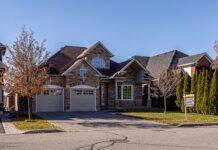Home price appreciation slowed ‘considerably’ in June, and some markets saw price gains practically go flat on a month-over-month basis, according to the S&P/Case-Shiller Home Price Index (HPI).
Nationwide, home prices gained 0.9% in June compared to May and were up 6.2% compared to June 2013. Although all metro markets measured in the report posted gains in June, the days of double-digit year-over-year gains appear to be behind us for now.
Although much progress has been made in terms of home price appreciation during the past 18 months, prices remain about 10% below their June-July 2006 peak.
‘Home price gains continue to ease as they have since last fall,’ says David M. Blitzer, chairman of the index committee at S&P Dow Jones Indices, in a statement. ‘For the first time since February 2008, all cities showed lower annual rates than the previous month. Other housing indicators – starts, existing-home sales and builders' sentiment – are positive. Taken together, these point to a more normal housing sector.’
As Blitzer explains, however, the slowdown in price appreciation means it will take longer for home prices to recover to their pre-recession levels.
‘In San Francisco, the pace of price increases halved since late last summer,’ he says. ‘The Sun Belt cities – Las Vegas, Phoenix, Miami and Tampa – all remain a third or more below their peak prices set almost a decade ago.’
Still, U.S. home prices as of June had returned to their levels posted in fall 2004, according to the report.
This month – for the first time – the S&P/Case-Shiller index includes a National Index, in addition to its 10-City and 20-City Composites. The two composites each posted month-over-month gains of 1% in June.
New York led the cities with a return of 1.6% – its largest increase since June 2013. Chicago, Detroit and Las Vegas followed with increases of 1.4%. Las Vegas posted its largest monthly gain since last summer.
Home price appreciation is, of course, a double-edged sword: On the one hand, rising prices is good for existing homeowners in that they regain equity lost in the recession, thus enabling them to ‘get out from underwater’ and possibly ‘upsize’ to a larger or more valuable home. On the other hand, rising home prices are bad for first-time or lower-income home buyers, in that it keeps them priced out of the market – particularly because mortgage credit is tighter than ever.
Should mortgage interest rates creep back up again, as forecast, it will likely make it even tougher for lower-income and first-time buyers to purchase homes. At the same time, however, rising rates will likely cause price appreciation to stay flat.
‘Bargain basement mortgage rates won't continue forever; recent improvements in the labor markets and comments from Fed chair Janet Yellen and others hint that interest rates could rise as soon as the first quarter of 2015,’ Blitzer says. ‘Rising mortgage rates won't send housing into a tailspin, but will further dampen price gains.’
Meanwhile, the Federal Housing Finance Agency's (FHFA) HPI shows that home prices increased 0.4% in June compared to May.
What's more, the report shows that home prices increased 0.8% for the second quarter compared to the first quarter and were up 5.2% compared to the second quarter of 2013.
It should be noted that the FHFA's HPI uses a different methodology than Case-Shiller, in that it only looks at homes with conforming mortgages that are sold to, or guaranteed by, Fannie Mae and Freddie Mac. This means the index excludes distressed and high-end sales.
As per the FHFA's HPI, U.S. home prices had, as of June, increased for 12 consecutive quarters and seven consecutive months.
‘The extraordinary price appreciation observed over the last few spring seasons was not evident in the second quarter of this year,’ says Andrew Leventis, principal economist for the FHFA, in a release. ‘However, house price appreciation for the nation as a whole remained positive. FHFA's data indicate that house price appreciation in the quarter was near or below the baseline rate of inflation in most states.’
Of the nine census divisions tracked in the FHFA report, the Pacific division experienced the strongest increase in home prices in the second quarter, posting a quarter-over-quarter increase of 1.3% and a year-over-year increase of 9.8%. Home price appreciation was weakest in the East South Central division, where prices decreased 0.1% from the prior quarter.
Earlier this month, Black Knight Financial Services and CoreLogic released HPI reports also showing that home price appreciation slowed considerably in June.
To check out the S&P/Case-Shiller HPI report, click here.
To check out the FHFA's HPI report, click here.










